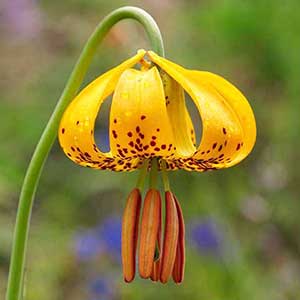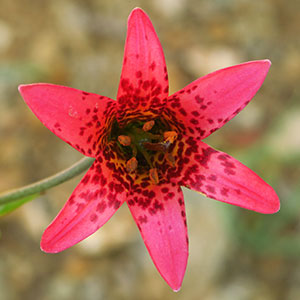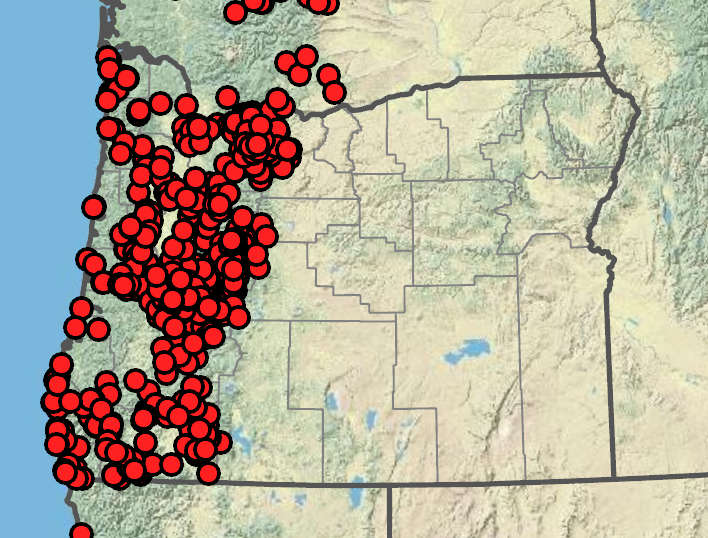Lilium columbianum
Lilium bolanderi
Columbia lily, Oregon lily, tiger lily
Bolander's lily
in 1–9 whorls, generally ascending, weakly oblanceolate to obovate, 1.5–16 cm;
margin generally wavy.
in 2–6 whorls, usually ascending and often cupping stem, generally obovate or oblanceolate, 1.8–7 cm, generally distinctly glaucous;
margin generally wavy.
flowers 1–25(45), pendent to nodding.
flowers 1–9, nodding to horizontal.
widely bell-shaped, not fragrant;
perianth segments 3.4–6.1(7.1)cm, orange (sometimes reddish outside);
distal 50–60% portion reflexed;
stamens longer than perianth;
filaments spreading;
anthers 5–13 mm; yellowish to very pale magenta;
pollen orange or yellow;
pistil 2.4–3.7 cm.
narrowly bell-shaped, not fragrant;
perianth segments 3–4.7 cm, red or magenta (rarely salmon or pale yellow); inner basal 30–50% portion usually yellowish;
distal 20–40% portion somewhat recurved;
stamens less than or equal to perianth;
filaments parallel or nearly so;
anthers 3–8 mm; reddish or magenta;
pollen red-brown, orange, or yellow;
pistil 2–3.5 cm.
2–5.4 cm.
2–4 cm.
=24.
=24.
Lilium columbianum
Lilium bolanderi
Dry scrub, coastal prairie, gaps and roadsides in conifer forest especially along coast. Flowering May–Aug. 0–2000m. Casc, CR, ECas, Est, Sisk, WV. CA, ID, WA; north to British Columbia. Native.
This widespread lily is rather variable. Oregon plants tend to have exserted stamens and the “Turk’s-cap” flower form associated with large butterfly pollination. Patches of flowering plants can be thick with western tiger swallowtails and pale swallowtails. Lilium columbianum hybridizes with L. pardalinum ssp. wigginsii and vollmeri, and extensively with L. occidentale in southern coastal Oregon. Lilium columbianum may intergrade with L. kelloggii along Highway 199 at the border between California and Oregon; these plants are slightly fragrant and the bulb scales unsegmented, all characteristics of Kellogg’s lily. Native Americans used Lilium columbianum bulbs as a food or peppery condiment. For many, it was a staple food (Pojar and MacKinnon 1994).
Serpentine soil in chaparral, conifer forests. Flowering Jun– Aug. 400–1400m. Sisk. CA. Native.
Lilium bolanderi can be fairly common in its preferred scrubby serpentine savanna habitat. Hybrids with L. pardalinum and L. washingtonianum ssp. purpurascens are possible. The range of corolla color variation from decidedly yellowish through red to maroon is extreme for the genus in North America—only L. canadense is similarly variable—but most are pale red to magenta. In Oregon, Bolander’s lily is primarily pollinated by rufous hummingbirds.
Mark Skinner
Mark Skinner
- Local floras:
BC,
CA,
OR,
WA
- Local Web sites:
CalFlora,
CalPhotos,
Flora NW,
PNW Herbaria,
Turner Photog.
WildflowerSearch
iNaturalist (observations)
USDA Plants Database
- LBJ Wildflower Center
- SEINet
- Plants of the World Online
- Encyclopedia of Life
- Wikipedia
- Google Image Search





